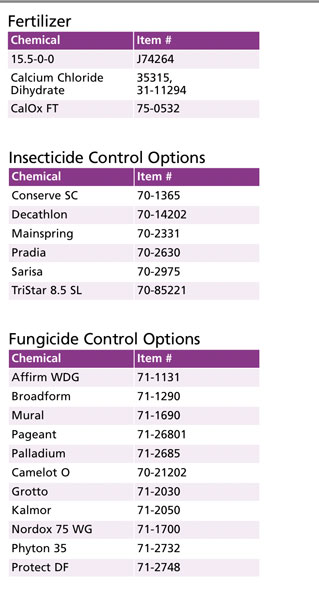8/1/2022
Beyond Fall Mums
Virginia Brubaker

The vibrant color that comes from ornamental cabbage and kale complements every combination pot and display garden. While these plants are often called flowering cabbage and kale, they’re actually grown for their colorful rosettes of leaves. Used in mass planting, they’re a good replacement for summer annuals that have fulfilled their obligation, providing additional color throughout fall and early winter.
Pictured top to bottom:
Calcium-related tip burn.
Aphids on kale.
Xanthomonas campestris on cabbage.
The onset of cooler fall temperatures helps to promote the vivid pink, red and white colors. Ornamental cabbage and kale really are cool-weather plants, and once acclimated, they can survive temperatures as low as 15F (-9C).
Let’s take a look at some areas that will help finish a successful crop.
Abiotic disorders
Ornamental cabbage and kale are subject to tip burn during hot and humid weather. This is a calcium-related problem due to poor transpiration during typical summer weather conditions. Various calcium sources can be used as foliar applications to greatly reduce the damage from tip burn. These calcium sprays all will benefit from the addition of CapSil to the tank mix at ½ tsp. per gal. or 8 oz. per 100 gal. to prevent the calcium from rolling off of the waxy leaves.
Foliar applications of 15.5-0-0 at 1 tbsp. per gal. or 27 oz. per 100 gal. or calcium chloride dihydrate at the rate of 0.5 oz. per 3 gal. or 1 lb. per 100 gal. can be used to supplement calcium. Sprays should be made once a week when conditions favor tip burn. Schedule applications during morning or evening hours to avoid phytotoxicity from the sprays and to slow drying time, which increases calcium uptake.
CalOx FT from BioSafe Systems uses patented technology to deliver calcium that moves through the plant even in the absence of transpiration. The “FT” stands for the calcium “Flow Through” that occurs by stimulating selective ion channels in the cell membranes, allowing calcium to flow through the cells.
Normally, calcium migrates outside of the cell membranes, around and through the cell walls, only being transported by water movement. Periods of cloudy and/or humid weather reduce water uptake and transpiration, limiting the supply of calcium to plant tissue, particularly the most terminal parts of the plant. CalOx FT increases cellular calcium throughout the plant. Apply CalOx FT as a coarse foliar spray every seven to 14 days at 18 fl. oz. per 100 gal. or 11/8 tsp. per gal. with CapSil at the rate above.
Growth regulators
Foliar sprays of Paclobutrazol* at 20 to 30 ppm are recommended as early as the liner tray to stop excessive stretch before transplanting. Bonzi is absorbed through the stems and the roots rather than leaves. A foliar spray should be directed into the crown so that it runs down the stem.
After transplant, a 1 ppm Bonzi drench can be applied as the plants cover the top of the pot. “Feather” type kale requires as much Bonzi at a 3 ppm drench. Plant growth regulators of any kind are not an option if your cabbage and kale are intended to be used in association with any food purposes.

Insects and diseases
Aphids, beetles, cabbage loopers and leafhoppers are the most prevalent insect pests that plague cabbage and kale. Several broad-spectrum insecticide sprays include TriStar (MOA 4A), Pradia (MOA 28/29), Sarisa (MOA 28) and Mainspring (MOA 28).
Mainspring is the only product that can be used as either a spray or a drench application. Conserve (MOA 5) and Decathlon (MOA3) are labeled for beetles, loopers and leafhoppers. Decathlon remains to be one of the few synthetic pyrethroids that isn’t labeled as a restricted-use pesticide in most states.
Botrytis, powdery mildew and fungal leaf spots are common disease pathogens found on cabbage and kale. The fungicide sprays that will provide preventative and curative control are Affirm (MOA 19), Broadform (MOA 7/11), Mural (MOA 7/11), Pageant (MOA 7/11) and Palladium (MOA 9/12).
A bacterial disease caused by Xanthomonas campestris pv. campestris with the common name of black rot can cause significant losses. Apply a copper-based spray, such as Camelot O (MOA BM2), Grotto (MOA BM2), Kalmor (MOA M1), Nordox 75 WG (MOA M1) or Phyton 35 (MOA M1). Adding a mancozeb such as Protect DF (MOA M03) to one of the previously mentioned copper products will further enhance control.
For pesticide recommendations, refer to the GGSPro “Insecticide and Fungicide Options” bulletin or the most recent GGSPro Technical Reference Guide.
Not all products are registered in all states. Some pesticides are restricted use in some states or regions and not others. It’s the responsibility of the applicator to read and follow all label directions. Labels can change without notice. Other products may also be safe and effective. GT
* Bonzi, Piccolo, Paclo Pro, Pac O
Virginia Brubaker is GGSPro Technical Support Supervisor for Griffin. She can be reached at ggsprotech@griffinmail.com.